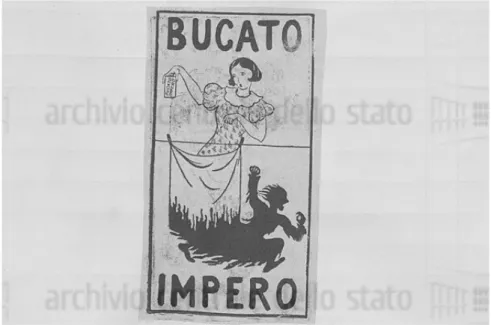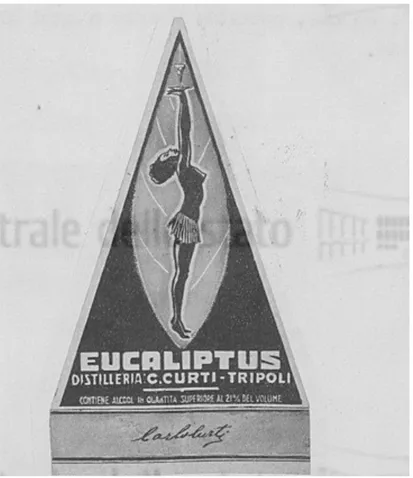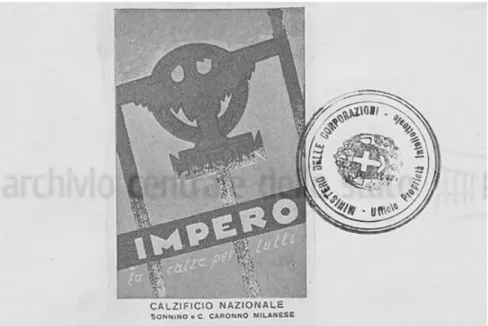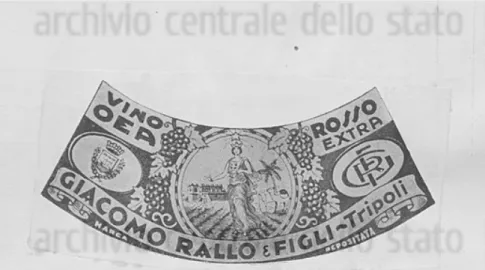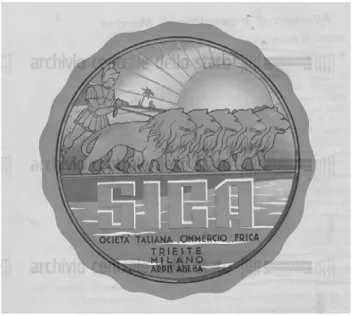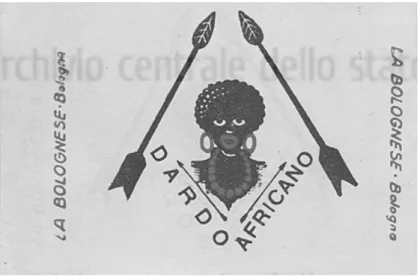abstr
act
Pedagogia Oggi / Rivista SIPED /anno XVIII / n. 1 / 2020
ISSN 2611-6561 online • ISSN 1827-0824 stampa
DOI: 10.7346/PO-012020-18 © Pensa MultiMedia, Lecce-Brescia 269
miscellanea
This paper uses an effective contextualisation of the images used in registered trademarks, to demonstrate how heuristic developments can go beyond the already-studied link be-tween material history and trademarks history (Hamilton 2009). It analyzes the meaning of a series of Italian trademark pictures with regards to the cultural environment which produced them and on which they impacted. It argued that those images played a role as indirect education factor as far as they strengthened stereotypes already promoted by in-stitutional racism.This contributes to a better understanding of the Italian colonial prej-udices in the 20thcentury (Gabrielli 2013; Labanca 2000; Triulzi 1999; Castelli 1998).
Keywords: Trademark, Cultural Studies, Racism, 20thCentury, History of
Educa-tion
Questo contributo intende mostrare come gli sviluppi euristici possano andare oltre le connessioni già indagate fra storia dei marchi e storia materiale (Hamilton, 2009), utiliz-zando un’efficace contestualizzazione culturale delle immagini allegate ai marchi deposi-tati per comprendere la costruzione del pregiudizio coloniale italiano nel Novecento (Ga-brielli 2013; Labanca 2000; Triulzi 1999; Castelli 1998). L’iconografia è analizzata per la sua valenza educativa indiretta nella costruzione e nel rafforzamento dell’immaginario coloniale fascista.
Parole chiave: Marchi, Studi culturali, Razzismo, Novecento, Storia dell’Edu-cazione
New sources of cultural history of education:
Italian trademark pictures as vehicles of colonial prejudices
during the Fascist era
Nuove fonti per la storia culturale educativa: le immagini dei marchi
come veicolo di pregiudizi coloniali in Età Fascista
Domenico Francesco Antonio Elia
Junior Researcher of History of Education | Department of Philosophical, Pedagogical and Economic-Quantitative Sciences | Gabriele d’Annunzio University of Chieti-Pescara | [email protected]
1. The colonial imagery in the Fascist era: studies and methodological
orientations
In his talk titled “Discipline Disambiguation” given during the Confe-rence held at the Italian Centre for Historical and Educational Research (CIRSE) in 2012, Betti mentioned the Fascism “with particular reference to topics regarding […] racial laws and colonial options” (2013, p. 588) amongst other issues which are considered as highly important nowadays in this field of study. The reasons behind the historiographical interest in colonial and racial politics during the Fascist era are attributable mainly to three factors: on the one hand it reflects the interest in the Italian co-lonial experience (Del Boca, 2007, pp. 18-21), and on the other, it shows the abundant studies of Italy as an occupying power (Focardi-Klinkham-mer, 2008, pp. 21-30). The third reason is linked to the consideration of racial laws in 1938 which is a topic to which CIRSE magazine has recen-tly dedicated a monograph section (2019: 2, pp. 1-248). Ever since the study on the origin of racial laws, the historians’ perception of this topic has thus greatly broadened “the ways in which the different conception of the race has been expressed in different cultures, ideologies, practices, as well as in different historical times and contexts” (Betta, 2016, p. 609). However, apart from environments related to school (Bottoni, 2006, pp. 125-151; Gabrielli, 1998; Id., 2013, pp. 313-325; Id., 2015a; Id., 2015b; Montino, 2007, pp. 193-216; Barrera, 2002, pp. 21-53; Palma, 2007, pp. 211-238; Polezzi, 2008, pp. 285-306) and literature for the young (Asioli, 2004a, pp. 55-83; Id., 2004b, pp. 67-104; Laforgia, 2004, pp. 210-239), little attention was paid to the study of the structure of co-lonial imagery. It is particularly notable how the public opinion ignored the detrimental effects arising from the circulation of images related to the production and trading of goods destined to the domestic market. In a largely illiterate society, images were a powerful instrument of propa-ganda and contributed to form the imagery of consumers. Regardless di-rect propaganda, Fascist racism was fostered indidi-rectly also by the circu-lation of images which conforms to its messages. Advertisers had causally recourse to widespread racist understanding “updated to the develop-ment of ethnological and geographic knowledge” (Nani, 2006, p. 91) and to the political circumstances of a totalitarian state pursuing colonial expansion. As a result, “they universalised and popularised racist con-cepts, stereotypes, and attitudes and made them available to a broad
cross-class spectrum of actual and potential consumers” (Hund, Picke-ring, 2013, p. 9). Outside the places of formal education, images conve-yed racist contents, and confirmed and boosted myths already existing in popular imagery (Castelli, 1998, p. 66). Colonial imagery resulted from a cultural process which included direct and – more often – indirect edu-cation influences contributing to the social formation of personality. Thus, the study of widespread advertising iconography can be conside-red part of the history of education intended as “the history of mentali-ties, behaviours, customs, symbols, models, myths, which have had […] an educational impact” (De Giorgi, 2004, p. 263).
This essay studies a historical source which has never been published so far. This source includes iconographical studies related to trademarks registered by enterprises at the Intellectual Property Office (Ufficio della Proprietà Intellettuale) (UPI) and preserved at the Central Archives of the State in Rome. This research aims to determine whether or not this iconographic presentation could have had an influence on the creation of colonial stereotypes, the so-called “Afriche icone” (“Africa as an Icon”) (Triulzi, 1999, p. 181). The study adopts the approach applied by Ga-brielli to the investigation of picture cards, focusing on pictures as “in-formal catalysts for children imagination […] which established a dou-ble sided relation of synergy and competition with images produced by the school” (Gabrielli, 2015a, pp. 244-245). Conversely, the target au-dience of pictures of trademarks were adults, who were influenced by ad-vertisement pictures. These constituted an indirect source of adult edu-cation which fostered “stereotypes and prejudices about blacks in order to advertise products” (Gabrielli, 1998, p. 26). Despite Gabrielli’s pio-neering studies in the Nineties, little attention has been paid to adverti-sing iconography in Italian history of education. On the other side, French studies about colonial advertising have been conducted since the 1980s (Bachollet, Debost, Leliur, 1997). The representations of Africa reflected the pedagogy of Fascist racism as based on the long-term con-struction of national identity (Padovan, 2006, p. 234). They constituted an indirect education tool as far as they aimed to “mobilise the whole so-ciety and convey a sense of national unity, instead of fostering an analysis or understanding of […] the African reality” (Triulzi, 1999, p. 169). In a largely illiterate society, the images of trademarks functioned as a me-ans “to communicate a derogatory racial meaning in more subtle way than an equivalent verbal statement” (Mendelberg, 2001, p. 9). The
re-271
search was conducted with the search engine http://dati.acs.benicultura-li.it/mm/local/ in which trademarks belonging to the period from 1923 and 1941 are selected. They include the following words: Abissinia,
Afri-ca, Colonia, Eritrea, Etiopia, Impero, Libia, Somalia, recording 184
oc-currences. All images can be found on the following web page: http://da-ti.acs.beniculturali.it/mm/local/ (last consulted: 05/02/2020). Provi-ding researchers with historical sources represented by the trademarks, which were already mentioned in Meda’s monograph (2016, p. 161), ba-sed on a study by Hamilton (2009, pp. 303-310), could circumvent tho-se “archival obstacles” which Sarfatti mentioned in one of his recent works (2016, p. 614).
2. The image of African otherness during the twenty years of Fascism
(1922-1943)
In its political programme, the Fascism focused on the Italian role in the Mediterranean, which exposed the Italians to a huge colonial propagan-da even before the Ethiopian War (1935-36). In fact, in 1926, a Colonial Day was declared, and in 1927 the press was reorganised with the publi-cation of the L’Oltremare (the Overseas) magazine under the management of the nationalist Roberto Cantalupo, and the year 1931 witnessed the setup of the “Conferences of Colonial Studies”. Moreover, Africa started to have a higher importance in the newsreels of the Istituto Luce, at the cinema and in colonial literature. The year 1925 witnessed the establi-shment of an award to a colonial novel (Labanca, 2002 pp. 243-245).
The conquest of Ethiopia enabled the Regime to create an economic and social hotbed within that area, which led to a totalitarian control over the movements of Italians and natives, and over the economic out-put (Podestà, 2004, p. 331). This way, Ethiopia was struck by a dispos-sessing process which deprived it of its history, and was considered by Mussolini as “a country without the slightest civilisation” (Preti, 1965, p. 100). So highlighted were “the concepts of African barbarity, of Ethiopia as the pro-slavery country which was ‘rescued’ by the Italian intervention (Catholic and Fascist), and of the impossible acceptance of the ‘Negro’ concept. This was the presupposition to the imposition of a racial regi-me” (Labanca, 2002, p. 251).
underlying the fascist colonisation, it is therefore useful to understand the nature of racism and the basis of the fascist ideology1. According to Padovan, the politics of racialisation towards the Africans stemmed up from self-racialisation through the “affirmation of one’s racial identity as a group that would subsequently claim their superiority over the others”. This is different from hetero-racialisation which is “aimed at creating relationships of domination, oppression, and exploitation […] in economic and labour sectors” (2006, p. 232). He concludes that the two models refer to two different types of racism: the first leads to anti-Semitism, while the second steers to colonial racism. With this in mind, “racist measures to segregate the Africans who were part of the Empire, were set forth to defend the race from contamination, rather than to control different races for the sake of economic slavery” (Padovan, 2006, p. 235). If it is evident that racial politics towards the Africans anticipa-ted those against the Jews (Mosse, 1980, p. 115), it is understood that Padovan’s hypothesis is partly different from Schneider’s – in which he claims that racism in the fascist colonial politics is different from those in the Nazi and English2models. In fact, unlike the latter models “Ita-lian politics stepped away from assimilating tendencies […], and sought, instead, to create a clear-cut division amongst the races, which is a type of politics that Schneider defines as ‘Apartheidrassismus’” (Per-gher, 2007, p. 64). The colonial law was based on two tools of modern imperialism, race and bureaucracy, the first of which can be interpreted as “an emergency definition which the Europeans use to react upon en-countering other human beings whom they were not […] willing to re-cognise as such”; and the other is a tool in the hands of the administrator “who used to govern through relations and legislations, with an impe-netrable secrecy stronger than that of an oriental despot” (Miele, 2012, p. 130).
It is worth noting that different types of colonial racism emerged in
273
DOMENIcO FRaNcEScO aNtONIO ELIa
1 According to Labanca the elements brought by the Fascism to colonialism were: “a highly racist approach, a nationalistic and classicistic emphasis [...], a populist into-nation (the colonies as a place for the expansion of Italian work)” (Labanca, 2002, pp. 251-252).
2 Common elements in different colonial experiences, however, persist in the design of territorial conquest supported “by a culture that unites racism and social Darwi-nism” (Flores, 2005, p. 31)
the Italian colonies on the basis of 19thcentury “colonial culture”3, and of the idea of an imperial destiny due to the biological superiority of the Italian race (Gabrielli, 2015b, 224). Gabrielli states that the fascist racism includes both “biological claims that point to an unbridgeable distance and nationalistic claims that hypothesize a subordinate assimilation” (2013, p. 371). These different types of racism tended to merge in the 1930s: institutionalised racism, due to legislative measures taken as of the year 1936 (Mosca, 2011, pp. 46-52); racism politics/political racism, which was linked to fascist international politics expressed by the Latin motto “divide and rule” “divide et impera”, and to violence against anti-colonial resistance; and mass racism characterised by daily occurrence (Labanca, 2002, p. 413 and seq.) This latter type was widespread and conveyed by images, perceptions, and behaviours (Labanca, 1999, p. 147). Illustrations in trademarks expressed this racist mass culture and contributed to strengthen and diffuse it.
3. A neglected historical source: the iconography in trademarks
regi-stered in the Fascist era
It is important to have a deep knowledge of the different types of racism within the fascist colonial system, because little research has focused on this specific topic, due to a number of causes such as the insufficiency of related themes caused by delays in Italian historical-colonial studies, and the lack of agreement among historiographical approaches (Del Boca, 1989, pp. 115-128). This research is part of cultural studies, already pro-moted by the book L’Africa nella coscienza degli Italiani (Africa in the
con-science of Italians) (Del Boca, 1992), thus demonstrating an interest in
the “widespread culture” of colonialism (Labanca, 2000, p. 151). Whilst being aware that avoiding the risks underlying these studies, we cannot ignore the fact how these studies have “put forward a new interpretation of the Italian colonialism and have represented the attraction exercised over the ordinary people by the colonies” (Pergher, 2007, p. 65). As such, I reckon it is necessary to grasp the heuristic suggestions made by De
3 “The Ethiopian war, the last enterprise of colonial conquest […] bridges the 19th century European imperialism and the Nazi war for German Lebensraum (living
Giorgi which aim to accept a cultural history of education, intended as a history “of effects of the ‘construction’ of personalities related to cultural, national, and international processes” (2004, p. 263). The creation of the propagandistic colonial imagery of the Fascist era strengthened the mili-taristic propaganda which on the one hand, “exalted the Italian power and stigmatised the ‘African barbarity’”, and on the other hand, suppor-ted “the exaltation of the imperial destiny of Italy and the prestige of be-longing to the superior white race” (Gabrielli, 1998, p. 37).
Within this new historiographical trend, Labanca cited the Immagini
& Colonie (Images and Colonies) exhibition, organised by Castelli in
19984(2002, pp. 151-152). The chronology adopted in the relating es-say (1998, pp. 58-62) which divides the colonial experience into five phases, is taken up in this document with regards to the period from 1923 until the fall of the fascist Empire (1941). Moreover, on the basis of iconographic categories used by Goglia regarding the enumeration of the Italo-Ethiopian war illustrated postcards, the following types of colo-nial imageries shall be analysed: symbolic, propagandistic, parodic, femi-nine, ethnographic, landscaping, and historical (1994, p. 29).
4. Types of trademarks in the Fascist era (1923-1941)
The statistical analysis of the categories of the Fascist colonial iconogra-phy reveals a surprising fact: the “symbolic” type reached the highest va-lue, that of (32%), while the propagandistic type (whether explicit or pa-rodic) reached on 6%. There were excluded those images (19%) which, although they contained references to colonial imagery, did not offer suf-ficient elements to fit them into the categories described above. However, statistical data have to undergo a qualitative analysis in order to avoid the fact that they subvert the herewith-discussed historiographical importan-ce, only because of their numerical preponderance. The “symbolic” ima-ges, in fact, demonstrate contents that can deeply affect the fascist colo-nial culture. These images are divided into the following two subcatego-ries: onomastic (78%) which include geographical metropolitan or
colo-275
DOMENIcO FRaNcEScO aNtONIO ELIa
4 Another valuable essay on the advertising iconography was published by Mignemi (1984, pp. 135-152); the author does not, however, dwell on the trademarks as a hi-storical source to reconstruct the colonial imagery.
nial names, and species of exotic plants and animals; and ideological (22%) which allude to the imperial dimension reached during the Fascist era in Italy.
The “onomastic” type reveals an interesting fact, namely, that in ad-dition to giving references to the motherland (Rome in particular), they also contain colonial place names with indications to a wide range of go-ods that include textiles, food products, cosmetics, and even chemical products. Such a wide range of colonial references can have stemmed from the familiarisation of the Italians with the imagery of the otherness. In fact, since the 1920s, the colonial issue had been included in the po-litics of the image, which expands from the propagandistic mechanism through a series of media messages based on Mussolini’s oratory, and cha-racterised by an “iconic, clear, and easily decipherable language” (Malva-no, 1988, pp. 18-19).
The role of the “symbolic” category in the building of colonial culture is strengthened by the other “ideological” subcategory. Amongst these il-lustrations there is the label of the “Edena Bartolini”, a laundry produ-cing company registered in June 1935. This image is of considerable in-terest, because it was deposited at the UPI one year before the proclama-tion of the Empire (9 May 1936), and it demonstrates that an aggressive imperialistic culture had already been widespread in public opinion. The illustration represents a woman washing a bed-sheet, and a black shape popping out under the detergent foam. This latter can be taken not only as the symbolic representation of dirt (traditionally associated with the colour black), but also as the allegory of the Africans who are forced to ignominiously flee from an Italian threat, represented here by the house-wife (Edena Bartolini, 1935).
Fig. 1: the trademark of Edena Bartolini
This thus confirms the image of the African, represented since the 19thcentury as “primitive” (Labanca, 2015, p. 260). Most of the images in this category bear the icon of the imperial eagle.
Then there is the “landscaping” category which represents the 25% of the images. They represent some themes like animals (16 occurrences), vegetables (15), anthropic themes (12), and then, two occurrences sho-wing a landscape devoid of life.
The anthropic category shows images of African and Arabian landsca-pes which rarely represent real monuments, with the exception of the Py-ramids and Tukuls, which are traditional buildings in East Africa, typical for being circular with cone-shaped roofs. The ideal element prevails in the others.
The third category shows images of otherness in various aspects of ethnographic representations (10%): food, languages, daily life, religion, and anthropology. The last two subcategories are the most relevant. The anthropological profiles show a double-sided approach to the issue of otherness: on the one hand pictures of colonials prevail, on the other the image of the Askari is crucial, being the “positive” figure par excellence in colonial culture. The perception to the idea of otherness, is faithfully
! ! ! ! ! ! 277
portrayed by the “Ruben Arbib Company” of Tripoli, and by the Indu-strial Company of Incense “Olibanum” in Mogadishu (Olibanum, 1938). Both enterprises are first-hand witnesses of that colonial reality which is misrepresented or distorted in trademarks registered by metro-politan companies. Of great importance are the trademarks of “G. Cara-melli” enterprise of Asmara: in order to show that the processing of meat was performed according to local religious customs, this company colla-borated with the Eritrean monastery of Debrè Bizen for meat destined to Christians (Ditta Caramelli, 1939), and had the meat sealed with “the stamp of the Grand Office Seyed Giafer El Morgani” (Ditta Caramelli, 1940) for the meat destined to Muslims.
The fourth category includes illustrations of women (5%). These are divided into two subcategories: one representing faces (7 occurrences), and the other shows full-length figures (3 occurrences). It is of interest to observe how in both subcategories the exotic woman is associated with seduction (Ponzanesi, 2012, p. 156). To register a perfume called “Pas-sion of Africa” (Benvenuto Fiorio, 1936), the Benvenuto Fiorio company chose a trademark depicting two heads of African women.
Likewise, in 1933 the Rodolfo Demofonti company registered a tra-demark depicting a half-naked Arab woman refreshing herself with an exotic drink (Ditta Rodolfo Demofonti, 1933) while lying languidly on bed. In cases where the seductive intent is not explicit, it is to be noticed that the African woman is portrayed bare-breasted, wearing only a mi-schievous skirt. This technique was adopted by Giuseppe Zamboni en-terprise. In 1936, this company registered a trademark for a liqueur cal-led “Somali Cream”. The trademark represented a “black woman in a yel-low field with green leaves in the background” (Giuseppe Zaniboni, 1936). Similarly, “Carlo Curti Distilling Company” of Tripoli, chose the figure of an African woman (Distilleria Carlo Cunti, 1939) for its regi-stered trademark of a liqueur.
Fig. 2: the trademark of Distilleria Carlo Cunti
In other cases, it is noticed that female figures are used in relation with the word “Africa” which indicates the strong link with this continent which was victim of European colonial processes (Polezzi, 2008, pp. 300-301; Restuccia, 2017, p. 16). The colonial expansion is indicated to by the metaphoric rape of the indigenous woman: the carnal control over the African woman is comparable to the domination over the colony (Surdich, 2003, p. 49). The eight propagandistic occurrences refer to tra-demarks registered in the 1930s, a period in which the fascist imperialism emerged. The oldest trademark appeared in 1931, by “Calzificio Nazio-nale Sonnino & C.”, which showed an eagle adorning the insignias of the Roman legions, decorated with the writing “Empire. Sock for everyone” (Calzificio Naz. F. Sonnino & Co, 1931).
! ! ! ! ! ! 279
Fig. 3: the trademark of Calzificio Naz. Sonnino & C.
The connection with the classical symbolism, already found in other images, is evident. What differentiates this illustration, however, is the link with the martial sphere represented by the banner of the legions, which symbolises the patriotism to which the fascism referred (Elia, 2018, pp. 19-29).
There is no lack of illustrations depicting the occupying power, per-sonified by a female farmer, which is the allegory for Italy, recognisable by her dress bearing the emblem of the Savoy shield and by the star on her head. She symbolises what enriches the colonies which were first abandoned to indigenous barbarities. This is the case of “Giacomo Rollo & Figli Company” which registered a trademark to produce and market Libyan wines (Soc. Col. G. Rallo, 1933).
! ! ! ! ! !
Pedagogia Oggi| XVIII | 1 |2020
Fig. 4: the trademark of Giacomo Rallo & Figli Company
The importance of agriculture in the Fascist propaganda was a theme dealt with also by the trademark of “Calzificio Carlo Doppieri S.A.”, which was registered in March 1936. Even before the proclamation of the Empire, this trademark had a caption specifying that “Calza Abissi-nia” (Abyssinian socks) “had been produced with the first cotton harvest in East Africa” (Calzificio C. Doppieri, 1936). Abyssinia was dominant in the illustrations of trademarks registered in the second half of the 1930s. The trademark of “Fedeli Sesta company” (1937) gave the name “Abyssinian” (Ditta Fedeli Sesta, 1937) to one of its laundry detergents, and put the face of an African man on it. The same name was given to a liqueur produced by “Prodotti Konfor Company”. The image illustrated in the trademark (1937) showed a tropical landscape with a caption sa-ying “The liqueur of victory” (Ditta Prodotti Konfor, 1937). The theme of military conquests and agriculture were depicted in the trademark by “Anonymous Company – Consortium of Italian Producers A.O.I” (1938), which represented a virgin agricultural land accompanied by “Italian Africa” (Soc. An. C.I.P A.C.I., 1940). The most spectacular ico-nography, both for the choice of colour illustrations and for the abun-dance of designs in it, is the one registered in 1938 by the Italian Com-pany of Commerce with Africa, in Trieste. This trademark depicted some iconic elements described above: the Roman soldier, who in the guise of a young farmer/civiliser, dominates five lions (symbol of African
exoti-! ! ! ! ! ! !
cism) which represent an alternative to the more traditional horse or ox driven chariots, usually used in agriculture work (Soc. Ita per il Commer-cio con l’Africa, 1938).
Fig. 5: the trademark of SICA company
This image contributes to the building up of “legitimacy myths” de-signed to justify the Italians’ stance as dominators (Volpato, 2002, p. 856). From the Fascist point of view, the Italians represented “the best of the ‘Aryan’ and ‘Roman’ races [...], which are considered to be the ideal prototypes of humanity” (Ivi, pp. 864-865). For propaganda purposes, the exotic continent had to give way to the “new Africa which was resha-ped and freed from barbarism [...] under the malleable intervention of the Fascism, considered as a civiliser not coloniser, who first conquered with the sword, then introduced civilisation and agriculture” (Laforgia, 2004, p. 229).
The last trademark in this category is the image in the trademark re-gistered by the Tripolitan company Aldo Egidio Brignone, specialised in iron and steel industry. This trademark might have been inspired by the Greek god Hermes holding a globe. The three words: “create”, “diffuse”, and “produce” (Aldo Egidio Brignone, 1940) are used as an attribution to the autarchic fascist politics. This type is related to that of a caricature
! !
! !
propaganda: the four occurrences highlight the physical or environmen-tal situations in which African subjects take on a parodic function. In or-der to advertise its confectionery products, “La Bolognese” of Mauro Bo-nesi of Bologna, had a figure of an African man whose body assumes the shape of an arrowhead (Ditta La Bolognese, 1939) on its registered tra-demark (1939).
Fig. 6: the trademark of Ditta La Bolognese
Similarly, the trademark of the company “Torrefazione A. Roversi” (1934) showed a black Brazilian, characterised by a twisted look and a forced smile, and holding a sheet of newspaper with the following sen-tence written on it: “Import Export Caffè Torrefazione – Bologna” (Ditta A. Roversi, 1934). Not less parodic is the image of the shoe polish pro-duced by “A. Sutter for Chemical and Technical products” (1936), which used a racist prototype that associated the colour of shoe polish to that of the skin of an African depicted on the trademark. Hence the name “Nero Abissino” (Fabbrica A. Sutter, 1936) (Abyssinian black) given to the pro-duct.
The last trademark, registered in 1940, is for a coffee substitute pro-duct called “Dutch Extract” which was produced by “An. Mannini, Volpi & C.” company in Fucecchio. The illustration depicts the face of a Ne-gus, made parodic by the artist (Soc. An. Mannini, Volpi & C., 1940).
In the last position (3%) come the illustrations depicting historical or mythological events. These images go back to affirm stereotypes of the
! !
! !
!
Italian talent of the centuries preceding its unification. They reflect geo-graphic explorations and historical events in Italian cities. Finally, there was no lack of references to a legendary corpus familiar to the Italians, linked to the need to recover features of being Roman, which legitimised the Empire in East Africa
5. Conclusions
The study of the iconography of trademarks registered in twenty years of the Fascist era is not able to univocally lean towards one or other of the racist models applied during the colonial empire. However, we cannot fail to mention how the reduced presence of African subjects in the ico-nography under study can reflect the politics which “draws its ideological foundations from an idea of a nation and civilisation which excludes a
priori the deemed dangerous presence of populations or ‘races’ not
rela-ted to the ‘Italian’ model” (Gabrielli, 1999, p. 201). It was an idea which had already been popular in Italy even before the promulgation of the ra-cist legislation. The Fasra-cist propaganda insisted on the need to keep the indigenous people in a kind of “natural state” and to reject the assimila-tion politics of the liberal age. As a result, images of the Africans present them on a remote and unchangeable background (Labanca, 2002, p. 252). Furthermore, we are not to forget the influence of the Manifesto
della Razza (The defence of race, 1, 1938, p. 1) in 1938 which clearly
men-tioned in its points 8 and 10 that there is a clear-cut distinction between the African and Mediterranean races. The delegitimization which follo-wed the Defence of the Race (Difesa della Razza) derives from non-ori-ginal models, typical of a long European tradition which considered the colonised people as reluctant to be civilised (Volpato, 2010, p. 275). The delegitimization – already taken for granted – was reinforced.
It is to be noticed, however, that there are some differences between the two colonial models: in the 19thcentury wars, the military paid high attention to the otherness idea, while in the memorial dating back to the Ethiopian war, this feeling diminished because of ethnographic ignoran-ce, colonial haughtiness, and for focusing on “white” masses of comba-tants as protagonists of the war (Labanca, 2015, p. 257). The illustrations used by Italian companies located in the colonies show a perception di-stant from that of the Empire myth which was widespread in Italy, while
in African domains, “the visual propaganda related to this myth is limited to advertising purposes” (Giuman, Parodo, 2011, p. 343).
Sources
http://dati.acs.beniculturali.it/mm/local/ Edema Bartolini, 1935: 51301-51500_0012.jpg. Olibanum, 1938: 57601-57800_0138.jpg. Ditta Caramelli, 1939: 58401-58600_0009.jpg. Ditta Caramelli, 1940: 62600-62800_0028.jpg. Benvenuto Fiorio, 1936: 54301-54500_0084.jpg.Ditta Rodolfo Demofonti, 1933: 46301-46500_0014.jpg. Giuseppe Zaniboni, 1936: 53901-54100_0088.jpg. Distilleria Carlo Cunti, 1939: 58201-58400_0210.jpg.
Calzificio Nazionale F. Sonnino & Co., 1931: 41301-41500_0112.jpg. Soc. Col. Giacomo Rallo, 1933: 46701-46900_0036.jpg.
Calzificio Carlo Doppieri, 1936: 52701-52900_0083.jpg. Ditta Fedeli Sesta, 1937: 56101-56300_0089.jpg.
Ditta Prodotti Konfor, 1937: 55101-55300_0090.jpg. Soc. An. C.I.P. A.C.I., 1940: 61403-61602_0009.jpg.
Soc. Ita. Per il Commercio con l’Africa, 1938: 57801-58000_0049.jpg. Aldo Egidio Brignone, 1940: 62201-62399_0036.jpg.
Ditta La Bolognese, 1939: 60202-60401_0085.jpg. Ditta A. Roversi, 1934: 49901-50100_0158.jpg. Fabbrica A. Sutter, 1936: 54301-54500_0201.jpg.
Soc. An. Mannini, Volpi & C., 1940: 61003-61201_0040.jpg.
References
Asioli V. (2004a). L’impero di carta. Il colonialismo italiana di età liberale nel-l’editoria per ragazzi (prima parte). Studi Piacentini, 35: 55-83.
Asioli V. (2004b). L’impero di carta. Il colonialismo italiana di età liberale nel-l’editoria per ragazzi (seconda parte). Studi Piacentini, 36: 67-104.
Bachollet R., Debost J.B., Leliur A.C. (1997). Négripub. L’immagine dei neri nella pubblicità. Torino: Gruppo Abele.
Barrera G. (2002). Patrilinearità, razza e identità: l’educazione degli italo-eritrei durante il colonialismo italiano (1885-1934). Quaderni Storici, 1: 21-53. Betta E. (ed.) (2016). Studiare il razzismo in Italia. Una questione di fonti?
terventi di Michele Sarfatti, Giorgio Fabre, Silvia Falconieri, Micaela Pro-caccia, Luc Berlivet, Giovanni Paoloni, Mauro Capoci e Gilberto Corbelli-ni. Contemporanea, 4: 609-651.
Betti C. (2013). Disambiguazioni disciplinari. In H.A. Cavallera (ed.), La ricer-ca storico-eduricer-cativa oggi. Un programma di ricerricer-ca (pp. 573-590). Lecce: Pen-sa MultiMedia.
Bottoni R. (2006). La guerra d’Etiopia a scuola: il colonialismo italiano e l’im-pero nella scuola fascista. Annali di Storia dell’Educazione e delle istituzioni scolastiche, 13: 125-151.
Castelli E., Del Boca A. (eds.) (1998). Immagini & Colonie. Montone: Centro di documentazione del Museo etnografico Tamburo Parlante.
CIRSE (2019). Scuola, università e leggi razziali. Una riflessione storico-educa-tiva sulle leggi razziali in Italia tra storia, storie, testimonianza e autobiogra-fia. Rivista di Storia dell’Educazione, 2: 1-248.
De Giorgi et alii (2004). La storia dell’educazione come storia culturale. Inter-venti a cura di Fulvio De Giorgi. Contemporanea, 2: 263-285.
Del Boca A. (1989). Le conseguenze per l’Italia del mancato dibattito sul colo-nialismo. Studi piacentini, 1: 115-128.
Del Boca A. (1992). L’Africa nella coscienza degli italiani. Miti, memorie, errori, sconfitte. Bari-Roma: Laterza.
Del Boca A. (ed.) (20072). I gas di Mussolini: il fascismo e la guerra d’Etiopia. Ro-ma: Editori Riuniti.
Elia D.F.A. (2018). Sport e Romanità nell’ideologia fascista. Progressus, 2: 19-44.
Flores M. (2005). Tutta la violenza di un secolo. Milano: Feltrinelli.
Focardi F., Klinkhammer L. (2008). Italia potenza occupante: una nuova fron-tiera storiografica. In Istituto romano per la storia d’Italia dal fascismo alla Resistenza (ed.), Politiche di occupazione dell’Italia fascista (pp. 21-30). Mi-lano: FrancoAngeli.
Gabrielli G. (1998). L’Africa in giardino: appunti sulla costruzione dell’immagi-nario coloniale. Anzola dell’Emilia: Grafiche Zanini.
Gabrielli G. (1999). Africani in Italia negli anni del razzismo di Stato. In A. Burgio (ed.), Nel nome della razza. Il razzismo nella storia d’Italia 1870-1945 (pp. 201-212). Bologna: il Mulino.
Gabrielli G. (2013). Il ruolo del dispositivo razzista nella storia del colonialismo italiano. Educazione Interculturale, 3: 313-325.
Gabrielli G. (2015a). Insegnare le colonie. La costruzione dell’identità e dell’al-terità coloniale nella scuola italiana (1860-1950) (PhD thesis, Macerata, University, 2015).
Gabrielli G. (2015b). Il curricolo razziale. La costruzione dell’alterità di razza e coloniale nella scuola italiana (1860-1950). Macerata: Eum.
Giuman M., Parodo C. (2011). Nigra subucula induti. Immagine, classicità e questione della razza nella propaganda dell’Italia fascista. Padova: CLEUP. Goglia L. (1994). Le cartoline illustrate italiane della guerra del 1935-1936: il
negro nemico selvaggio e il trionfo della civiltà di Roma. In Centro Furio Je-si (ed.), La menzogna della razza: documenti e immagini del razzismo e del-l’antisemitismo fascista (pp. 27-41). Bologna: Grafis.
Hamilton D. (2009). Patents: a neglected source in the history of education. History of Education, 2: 303-310.
Hund W.D., Pickering M. (2013). Colonial Advertising and Commodity Racism. Münster: LIT Verlag.
Labanca N. (1999). Il razzismo coloniale italiano. In A. Burgio (ed.), Nel nome della razza. Il razzismo nella storia d’Italia 1870-1945 (pp. 145-163). Bolo-gna: il Mulino.
Labanca N. (2000). Imperi immaginati. Recenti cultural studies sul coloniali-smo italiano. Studi piacentini, 28: 145-168.
Labanca N. (2002). Oltremare. Storia dell’espansione coloniale italiana. Bologna: il Mulino.
Labanca N. (2015). Una guerra per l’impero: memorie della campagna d’Etiopia, 1935-36. Bologna: il Mulino.
Laforgia E.R. (2004). Il colonialismo italiano spiegato ai fanciulli. In L. Finoc-chi, A. Gigli Marchetti (eds.), Editori e piccoli lettori tra Otto e Novecento (pp. 210-239). Milano: FrancoAngeli.
Manifesto della razza (1938). La difesa della razza, 1: 2.
Malvano L. (1988). Fascismo e politica dell’immagine. Torino: Bollati Boringhie-ri.
Meda J. (2016). Mezzi di educazione di massa. Saggi di storia della cultura mate-riale della scuola tra XIX e XX secolo. Milano: FrancoAngeli.
Mendelberg T. (2001). The Race Card: Campaign Strategy, Implicit Message, and the Norm of Equality. Princeton: University Press.
Miele C. (2012). Per un’archeologia del discorso razzista in Italia. In A. Curcio, M. Mellino (eds.), La razza al lavoro (pp. 121-139). Roma: Manifestolibri. Mignemi A. (ed.) (1984). Immagine coordinata per un impero. Etiopia 1935-36.
Torino: Editoriale Forma.
Montino D. (2007). Libro, quaderno e moschetto. Pedagogia della guerra nelle letture e nelle scritture scolastiche durante il regime fascista. History of Edu-cation & Children’s Literature, 2: 193-216.
Mosca L. (2011). Italiani in colonia, Africani in Italia: from scramble for Africa to scramble for Italy. L’Ape Ingegnosa, 1-2: 43-60.
Mosse G.L. (1980). Il razzismo in Europa dalle origini all’Olocausto. Roma-Bari: Laterza.
Nani M. (2006). Ai confini della nazione. Stampa e razzismo nell’Italia di fine Ottocento. Roma: Carocci.
Padovan D. (2006). Le scienze sociali e la costruzione dello spazio pubblico: il caso del razzismo fascista. Rassegna Italiana di Sociologia, 2: 225-268. Palma S. (2007). Educare alla subalternità. Prassi e politiche scolastiche nella
colonia eritrea. In B.M. Carcangiu, T. Negash (eds.), L’Africa orientale ita-liana nel dibattito storico contemporaneo (pp. 211-238). Roma: Carocci. Podestà G.L. (2004). Il mito dell’impero: economia, politica e lavoro nelle colonie
italiane dell’Africa orientale, 1898-1941. Torino: Giappichelli.
Polezzi L. (2008). L’Etiopia raccontata agli Italiani. In R. Bottoni (ed.), L’impero fascista: Italia ed Etiopia, 1935-1941 (pp. 285-306). Bologna: il Mulino. Ponzanesi S. (2012). The color of Love: Madamismo and the Interracial
Rela-tionships in the Italian Colonies. Research in African Literatures, 2: 155-172. Preti L. (1965). I miti dell’impero e della razza nell’Italia degli anni ’30. Roma:
Opere Nuove.
Pergher R. (2007). Impero immaginario, impero vissuto. Recenti sviluppi nella storiografia del colonialismo italiano. Ricerche di storia politica, 1: 53-66. Restuccia L. (2017). Mio Dio, puniscimi perché ho peccato! Rapporti
illegitti-mi e senso di colpa negli anni dell’Impero. InVerbis, 1: 13-43.
Sarfatti M. (2016). Gli impacci della ricostruzione. In E. Betta (ed.), Studiare il razzismo in Italia: questioni di fonti? Contemporanea, 4: 612-617. Surdich F. (2003). La rappresentazione dell’alterità italiane nei resoconti degli
esploratori italiani di fine Ottocento. In M. Colin, E.R. Laforgia (eds.), L’Afrique coloniale et postcoloniale dans le culture, la littérature et la société ita-liennes (pp. 41-60). Caen: PUC.
Traverso E. (2002). La violenza nazista. Una genealogia. Bologna: il Mulino. Triulzi A. (1999). La costruzione dell’immagine dell’Africa e degli africani
nel-l’Italia coloniale. In A. Burgio (ed.), Nel nome della razza. Il razzismo nella storia d’Italia, 1870-1945 (pp. 165-181). Bologna: il Mulino.
Turi G. (2002). Lo Stato educatore. Politica e intellettuali nell’Italia fascista. Ro-ma-Bari: Laterza.
Volpato C., Durante F., Cantone A. (2002). “Popolo di poeti, di artisti, di eroi, di navigatori…”. Lo stereotipo dell’italiano in epoca fascista. Giornale italia-no di psicologia, 4: 851-875.
Volpato C. et alii (2010). Picturing the Other: Targets of Delegitimization across Time. International Journal of Conflict and Violence, 2: 269-287. <https://www.rivistadistoriadelleducazione.it/index.php/RSE/issue/view/6/6>
